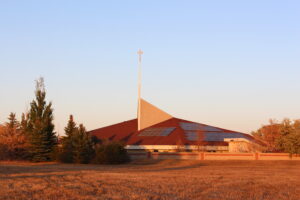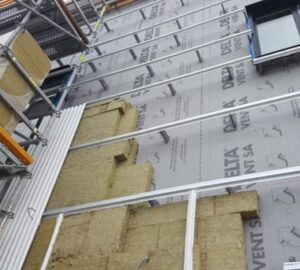Taking a deeper risk

KAIROS Regina invites you on a journey of faith, one that challenges our comfortable lives and changes the very buildings we worship in. On October 15, KAIROS Regina will host a one-day hybrid conference called, “Creation Care in our Places of Prayer: Energy Retrofits and other Faith-based Climate Action.” In the leadup to that session, they have offered six articles to prepare our hearts and minds for the deep transformation that is needed. This final article is by Matt Dipple (engineer and building consultant), who serves on the Climate Justice Working Group for KAIROS Regina.
Our previous blog posts called on faith communities to be fearless and ambitious in tackling emissions. We shared some successes, and considered how to start small and gather broad support. This week, we offer a companion to one of our workshop presentations on deep retrofits.
If you have been following our blog posts the past few weeks, perhaps you are feeling a desire to do more to reduce the negative environmental impacts of your church building. But beyond recycling, LED light bulbs, and solar panels, how can your church building move towards a low-carbon future? One of the most impactful ways is by undergoing a deep energy retrofit.
While there is no single agreed-upon definition, deep energy retrofits typically involve a whole-building renovation plan to reduce energy use by upwards of 50%. The work has many elements, including adding insulation, reducing air leakage, upgrading windows and doors, replacing heating and cooling systems, upgrading ventilation, replacing lighting, adding high-efficiency water heating, and adding renewable energy.

At present, one of the leading methodologies for deep energy retrofits is called “passive design.” Passive design encourages reducing energy use as much as possible before upgrading heating and cooling systems and adding renewable energy. Because they make up the majority of building energy use, there is a strong emphasis on reducing heating, cooling, and hot water energy use. The result is a building which requires very little heating and cooling in the first place—one which can then have much smaller heating and cooling equipment, and a smaller renewable energy system. The adage “waste not, want not” comes to mind.
Worship spaces provide some unique challenges when it comes to deep energy retrofits. Often churches are places of architectural significance, which can make changes to the exterior a balance between preparing for the future and preserving the past. Churches may need significant repairs and other upgrades before retrofit work can begin. In the face of declining attendance and budgets for many churches in Canada, the cost and extent of a deep energy retrofit can be daunting.
On the other hand, church energy retrofits have the potential for significant positive impact. Church buildings are gathering places in the community; pairing a retrofit project with efforts to educate those who use the building on the motivation and benefits of the project can magnify the ecological impacts far beyond the energy use of one building. In addition to saving energy, deep energy retrofits can also dramatically improve the health, comfort, and functionality of the church building, and infuse it with new life. (Perhaps it is the building equivalent of being “born again!”)
I have been confronting these challenges and opportunities in considering my own church, which is a Cathedral that is over 100 years old, with a shoestring operating budget and large utility bills. I am on a working group to help plan renovation projects for the building. At present, budget constraints have limited our renovations to urgent structural, safety, and accessibility items. Climate change has its own urgency, and yet it seems all we can do is keep treading water while the sea level rises. The intellectual part of me feels defeated. Perhaps you can relate.
For me, this is a touchpoint where faith meets intellect—where hope goads melancholy. Like the calling of Matthew, the tax collector, Jesus is calling us to trust beyond our understanding, saying to us, “Get up, come and follow me!” Surely Matthew was tempted to play it safe and remain firmly in the world of facts and figures, rather than follow the call of this wild Rabbi.
Let us welcome God’s Holy Spirit in her wisdom and creativity, to put wet mud on our blind eyes. Let us take risks as churches! It must have taken tremendous effort and risk to build each of these church buildings in the first place. Let us try new ideas, seeking the Spirit which is always drawing us into new life and ways of being.
